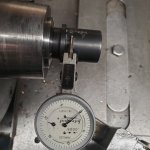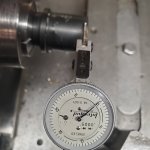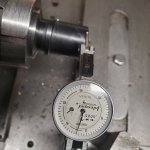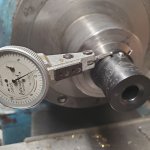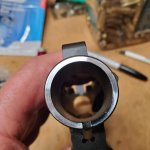something’s wrong with me…this thread must’ve given me a TBI…I read it like thisI've already started laughing myself into a nut job
Join the Hide community
Get access to live stream, lessons, the post exchange, and chat with other snipers.
Register
Download Gravity Ballistics
Get help to accurately calculate and scope your sniper rifle using real shooting data.

Install the app
How to install the app on iOS
Follow along with the video below to see how to install our site as a web app on your home screen.
Note: This feature may not be available in some browsers.
You are using an out of date browser. It may not display this or other websites correctly.
You should upgrade or use an alternative browser.
You should upgrade or use an alternative browser.
Barrel Torque Ludicrocity
- Thread starter Ronin22
- Start date
See i told you it's startingsomething’s wrong with me…this thread must’ve given me a TBI…I read it like this
Mike
Honest to god I couldn't tell if you were being sarcastic about those torque values. About how much torque does it take to break an action wrench and is that the limiting factor on how much most people can torque a barrel on or is it damage to the action caused by the wrench?See i told you it's starting
lol
Mike
Well I talked with Mike on the phone and apparently those torque numbers are legit. Got some cool info on some other aspects of riflebuilding too which was fun (and a cool book recommendation as well).
No...So a jam nut at 55ftlbs is imparting more/equal torque on the barrel nut face and receiver face than a 100ftlbs shouldered prefit?
The jam nut on a prefit is even different than a nut pushing back on the barrel extension ring.
Everything should be perfectly square as possible...or the barrel is pulled off center as tbe slack in the threads take up torque on an uneven surface or just jammed by the nut alone in the case of a barrel nut in different applications.
Why suppressors & some muzzle breakes do not recommend crush washers, or jam nuts ...but direct timmed mounts or precision shims so baffle strikes don't happen.
On ARs I always square, glue in, and torque to 60 ft/lbs never less, and never more on aluminum threads saved by the hard anodizing and applied anti-seeze
And mill a slot if the barrel nut groove does not line up for the gas tube and some use a steel nut that does not require lining up a slot.
Factory installed barrel extension butted up against a supposed factory square shoulder.
Scrapped the glue off this pre installed barrel in one area to get a reading straight across the length of the extension
Its pretty close to zero- zero, and .0002" TIR on tbe barrel itself...
but the runout on the end of the barrel extension is .002" and the face around. 001". Imagine your 16" barrel is attached pointing down range at a slight angle.
Plus any reciever portion out of square, or the barrel nut itself.
And thats not all of the problems to address.
Plus ARs flex easily...the best non AR barrel to reciever is mating is the solid receiver directly to barrel shank no barrel nuts, clamping the threads, or set screws...but with precision threads, lubed and torqued to at least 95 plus ft-lbs...IMO
But you all do whatever ya want...maybe a quick change barrel or take down method is more important than best accuracy potential
Attachments
Last edited:
Nah, that’s exactly the way it is loaded.Which is still wrong.
I enjoyed the conversation as well and definitely made a newWell I talked with Mike on the phone and apparently those torque numbers are legit. Got some cool info on some other aspects of riflebuilding too which was fun (and a cool book recommendation as well).
Call anytime it was my pleasure and definitely check that book out you'll learn a couple of interesting things I'm sure...
Mike R
What book?I enjoyed the conversation as well and definitely made a newNINJA friend...
Call anytime it was my pleasure and definitely check that book out you'll learn a couple of interesting things I'm sure...
Mike R
Bottom right, which direction is the force being applied in the red circles when the screw (blue) is tightened?It isn't.
They’re the sane thing rotated 90*Then the arrow in your top drawing shows the force being applied 90 degrees to your bottom drawing. Bottom drawing correct. Top drawing incorrect.
Not if your red circles are to be believed. Section lines would definitely help.They’re the sane thing rotated 90*
The book is called TIGERS REVENGE By Claude Balls it's a great read my NinjaWhat book?
Just playing
Mike R.
Just had a similar conversation on another forum and Harold Vaughn's book was referenced. Oddly enough, the conversation started with scope drop test validity and Aaron Davidson of Gunwerks pointed out issues with the action barrel joint being a variable that isn't corrected for. Quoting his post there on the action/barrel joint:

In turn, he suggested smooth threads and square face is the best way to ensure the joint stays in or returns to the same place.They don't stay locked up. The axial preload you can max without yielding is less than the force generated by the cartridge expansion on firing that is opposite the thread preload.
Last edited:
I for one would agree but what would I knowBut 100lb/ft is, "ludicrous".
Mike R.
Harold Vaughs book was amazing, at least to me (no formal engineering background, just life long shooter, amateur gunsmith). Opened a whole world of possibilities, or at least made me think about a bunch of things that i never considered before.
Any thoughts on the threadform he suggested? The idea being it had a special shape that would allow for a little deformation in the threads, spread the load out more evenly. IE, instead of the first thread carrying say 60% of load, next one 20%, next one 20%, it was more like.... 35/25/15/10/5 (just made up those #s for sake of argument, but the principle i took away was that he was achieving some loading across at least 5 threads, and the difference from one thread to another was much smaller than in typical 60 degree threads....)
My first guess is that, I dont really hear about anyone doing that thread form now, so it either wasn't useful or wasn't useful -enough-
But I also dont know / cant remember the torque values he was going to. (from memory, i think they were on lower end, but *shrugs* been a long time) I suspect that the torque values being discussed here (100lbs or way more) are enough to start causing at least some deformation, even if elastic, and that deformation starts spreading out the load too, even if threadform is conventiional (elastic deformation being the threads flex, but not so much that they dont return to initial shape after load removed). Getting into several hundred lb ft probably starts permanently distorting threads a bit, even though might be hard to see by eye (except for seeing change in surface texture - seeing shiny areas on first thread or two)
It DOES seem like there is a correlation between factory rifles that are known for being out-of-the-box accurate and also that take a ton of torque / heat / cutting shoulder to remove (like tikkas, sakos, hell look at the old steyr SSG69s - that wasn't even threaded, just a temp difference shrinkfit, which was tight enough it needed to be machined out to replace barrel once they had been mated together and temps had equalized). There are lots more, just grabbed a few examples off the top of my head. And to be fair, some of them are employing threadlocker on top of high torque, but, still..... there does seem to be a correlation with good shooting factory guns and barrel / receiver joint that is very tight. Of course there are a thousand things that have to happen to make accurate rifle, just cranking hell out of barrel doesn't ensure success - everything has to be right, or at least in right ballpark (otherwise people would be winning BR championships with old Eddystones and turkish mausers)
Any thoughts on the threadform he suggested? The idea being it had a special shape that would allow for a little deformation in the threads, spread the load out more evenly. IE, instead of the first thread carrying say 60% of load, next one 20%, next one 20%, it was more like.... 35/25/15/10/5 (just made up those #s for sake of argument, but the principle i took away was that he was achieving some loading across at least 5 threads, and the difference from one thread to another was much smaller than in typical 60 degree threads....)
My first guess is that, I dont really hear about anyone doing that thread form now, so it either wasn't useful or wasn't useful -enough-
But I also dont know / cant remember the torque values he was going to. (from memory, i think they were on lower end, but *shrugs* been a long time) I suspect that the torque values being discussed here (100lbs or way more) are enough to start causing at least some deformation, even if elastic, and that deformation starts spreading out the load too, even if threadform is conventiional (elastic deformation being the threads flex, but not so much that they dont return to initial shape after load removed). Getting into several hundred lb ft probably starts permanently distorting threads a bit, even though might be hard to see by eye (except for seeing change in surface texture - seeing shiny areas on first thread or two)
It DOES seem like there is a correlation between factory rifles that are known for being out-of-the-box accurate and also that take a ton of torque / heat / cutting shoulder to remove (like tikkas, sakos, hell look at the old steyr SSG69s - that wasn't even threaded, just a temp difference shrinkfit, which was tight enough it needed to be machined out to replace barrel once they had been mated together and temps had equalized). There are lots more, just grabbed a few examples off the top of my head. And to be fair, some of them are employing threadlocker on top of high torque, but, still..... there does seem to be a correlation with good shooting factory guns and barrel / receiver joint that is very tight. Of course there are a thousand things that have to happen to make accurate rifle, just cranking hell out of barrel doesn't ensure success - everything has to be right, or at least in right ballpark (otherwise people would be winning BR championships with old Eddystones and turkish mausers)
This is a great thread.
To all the machinist/gunsmith guys, mech engrs too -- with any joined pair of parts, there's always a few different options on how to make this cylinder/bore junction work, right? Threads as most common. And then you have threading choices, as well as fail-safe mechanisms (i.e. torque appropriate for threads/metals used, or clamp/stopper/plug of some kind to either close the bore onto the cylinder, or jam the cylinder in place)
And they're all trying to prevent the cylinder from shifting fore/aft in the bore, right?
Have there been designs that showed promise on paper but failed in use, in the past 50 or so years?
To all the machinist/gunsmith guys, mech engrs too -- with any joined pair of parts, there's always a few different options on how to make this cylinder/bore junction work, right? Threads as most common. And then you have threading choices, as well as fail-safe mechanisms (i.e. torque appropriate for threads/metals used, or clamp/stopper/plug of some kind to either close the bore onto the cylinder, or jam the cylinder in place)
And they're all trying to prevent the cylinder from shifting fore/aft in the bore, right?
Have there been designs that showed promise on paper but failed in use, in the past 50 or so years?
Hey @MikeRTacOps, have you ever played with the shape of the receiver face? Like singe or dual tapers with matching shoulder tapers on the barrel?
Preston Pritchett held all of Harold Vaughn's work in high regard.Harold Vaughs book was amazing, at least to me (no formal engineering background, just life long shooter, amateur gunsmith). Opened a whole world of possibilities, or at least made me think about a bunch of things that i never considered before.
He studied all of the theories and methodologies and where possible applied them to the design of the original Surgeon Tactical action that later became the M591.
I do have a certain style of posting threads that I think invigorates thought and in hopes of bringing those smarter and more experienced than me into the discussion.But 100lb/ft is, "ludicrous".
I am also not against saying I’m wrong. If fact, I think it takes a real man to admit fault.
I’m glad I did this thread because I learned a lot. In fact I think I’ve learned more in this thread than any others to date.
There was some brief mention, but this helped influence my title!
Last edited:
I keep everything Square it works best for me...Hey @MikeRTacOps, have you ever played with the shape of the receiver face? Like singe or dual tapers with matching shoulder tapers on the barrel?
Mike R.
If there was taper on front of receiver / barrel shoulder, id worry theyd fight the action / barrel threads. Theyd all have to be perfectly concentric with each other (i think they might need to be aligned in some other axis too, dont have good term for it), or the two sets would be trying to point barrel in different directions. The barrel/action threads will be self centering on their own, due to the slope of 60 degree threads acting on each other. Much easier to have action face/ barrel shoulder dead flat and parallel to their own centerline and therefore to each other (easy to check while chucked up in lathe on lathe, easy to fix if needed at that point).
(Just my two cents on the matter, i know i wasnt the one asked)
(Just my two cents on the matter, i know i wasnt the one asked)
Harold Vaughs book was amazing, at least to me (no formal engineering background, just life long shooter, amateur gunsmith). Opened a whole world of possibilities, or at least made me think about a bunch of things that i never considered before.
Any thoughts on the threadform he suggested? The idea being it had a special shape that would allow for a little deformation in the threads, spread the load out more evenly. IE, instead of the first thread carrying say 60% of load, next one 20%, next one 20%, it was more like.... 35/25/15/10/5 (just made up those #s for sake of argument, but the principle i took away was that he was achieving some loading across at least 5 threads, and the difference from one thread to another was much smaller than in typical 60 degree threads....)
My first guess is that, I dont really hear about anyone doing that thread form now, so it either wasn't useful or wasn't useful -enough-
In the other discussion it was mentioned that Stiller for a while made some version of the "ramp thread" from the book but it wasn't popular so it got abandoned. This whole discussion also makes me wonder how this applies to "prefit" vs "fitted" barrels and how tennon threads cut a little looser to guarantee fit for the home gun plumber vs tighter "fitted" might impact the behavior of the joint. I was previously of the assumption that once torqued, this joint didn't move in the fitted vs pre-fit debates. This is all in the noise for most people as our performance on the gun is a much larger variable to improve but still interesting to me.
"The Book" being Robert Vaughn's tome on his experiments in rifle repeatability experiments?In the other discussion it was mentioned that Stiller for a while made some version of the "ramp thread" from the book but it wasn't popular so it got abandoned. This whole discussion also makes me wonder how this applies to "prefit" vs "fitted" barrels and how tennon threads cut a little looser to guarantee fit for the home gun plumber vs tighter "fitted" might impact the behavior of the joint. I was previously of the assumption that once torqued, this joint didn't move in the fitted vs pre-fit debates. This is all in the noise for most people as our performance on the gun is a much larger variable to improve but still interesting to me.
As far as thread fit... this is where pre-load comes into the question. In a threaded joint once the preload applied exceeds the load that the joint will cycle through it becomes moot for the low cycle count these joints see. Even though 10,000 rounds down a 223 barrel might sound like a lot it's still not even on most S-N diagrams for fatigue loading.
Harold Vaughn's Rifle Accuracy Facts, yes."The Book" being Robert Vaughn's tome on his experiments in rifle repeatability experiments?
I was not considering anything about the number of cycles but rather the case of a fired round exerting a load on the threaded joint that exceeds the preload applied as Aaron Davidson stated occurs even with over 100 ft/lb torque on a barrel. If we agree the joint is moving when the force of a fired round exceeds that of the pre-load, would tighter fitting threads or "ramp threads" as outlined in Vaughn's book help encourage the barrel to come back to the same location after the load from the fired round is gone?As far as thread fit... this is where pre-load comes into the question. In a threaded joint once the preload applied exceeds the load that the joint will cycle through it becomes moot for the low cycle count these joints see. Even though 10,000 rounds down a 223 barrel might sound like a lot it's still not even on most S-N diagrams for fatigue loading.
Biggest question on this topic… are your torque wrenches in MIL or MOA.
SAEBiggest question on this topic… are your torque wrenches in MIL or MOA.
Def MIL.Biggest question on this topic… are your torque wrenches in MIL or MOA.
How did I know you'd come up with thatBiggest question on this topic… are your torque wrenches in MIL or MOA.
I'll be telling my grandchildren about you tonight at bedtime
Mike R
Biggest question on this topic… are your torque wrenches in MIL or MOA.
Barrel torque calibration: 18" breaker bar to action wrench, wrench parallel to ground, put weight on end of breaker until almost no weight is on your feet -> torqued to spec. Calibrate differently if you're a moose and you break the action wrench.
I'm starting to sense you guys are leaving some accuracy on the table by not testing different torque specs while doing load development/primer- bullet seating tests.
I went with 69 (no homo) ft/lbs, because, well, you know...

I went with 69 (no homo) ft/lbs, because, well, you know...
Technically the correct answer is 42… but just seems too… little…
Perfect! That's it people. It's settled. 42 yard pounds of torque. We can close this thread now.42 yrdlbs seems about right. Should equal roughly 126ftlbs.
I torque barrels on at 70lbs......clicker torque wrench/impact socket and "in the action style action wrench."@AccuSol-ERN - I got a beautiful BA from you a few years ago. Deviant and a Bartlein blank I sent you. What torque do you use on a barrel install?
@MikeRTacOps - yeah…not bc asking for your secret sauce, but do you torque your barrels to at least 100 ft/lbs or greater?
Thanks
I've yet to find a reason to exceed this. If you take machining seriously and leave a good surface finish on the barrel shoulder and cut the threads specific to the action.....you will get hardly any rotation whether its 50lbs or 100lbs.
Same goes for headspace......its not like extreme torque is shifting headspace by moving the mating surfaces......you are just stretching and distorting the threads.
I like enough torque that stuffs stays put, but the least amount acceptable to avoid possible distortion (mostly on thin walled stuff). I've seen a few guys CRANK brakes on trying to get them timed up and have accuracy issues.
Ern
Just because you are an engineer doesn't mean you are correct. I don't cut prefits for ARC actions anymore. They can't seem to hit their own specifications..... +.004" headspace from their own print is garbage.I have a CDG and Ted is a mech engineer with all the supporting models and data to back up his spec.
I listen to Ted and sleep well without worry.
Ern
Hi Ern - I said he “is an engineer with all the supporting models and data to back up his spec”. The second half is relevant, I believeJust because you are an engineer doesn't mean you are correct. I don't cut prefits for ARC actions anymore. They can't seem to hit their own specifications..... +.004" headspace from their own print is garbage.
Ern
As to his manf QC, I have no knowledge of that and made no claims about it.
Cheers
Just because you are an engineer doesn't mean you are correct. I don't cut prefits for ARC actions anymore. They can't seem to hit their own specifications..... +.004" headspace from their own print is garbage.
Ern
Interesting, +0.004" over print dimension is certainly enough to cause an issue with a prefit and I don't blame you for not wanting to do prefits for them anymore... Nobody likes dealing with returns and reworks when it could have been avoided.
I'm sure you've measured a much larger sample size of ARC actions than I have, but between 9 ARC actions of 3 different models that share an identical tenon print that I've measured, they've all measured well within the print tolerance, and all 9 actions measured within a total span of 0.0012" even when swapping bolt heads around between all the actions.
The 9 I've measured were certainly good enough for prefits but like any chamber job regardless of action brand, if you want to hit an exact headspace dimension you either need the action in hand or accurate action face to bolt face measurements.
If I'm ordering a custom prefit, even for an action that supposedly guarantees an action face to bolt face dimension within +/- 0.001" according to the manufacturers print, I always provide the smith with a measurement from the action face to the bolt face taken with a calibrated depth mic measured multiple times in multiple spots on the bolt face on my action that the barrel will be going on. Doing this I've yet to find any out of spec dimensional surprises regardless of brand, but I'm sure you've measured many more actions than I have and can note trends and deviations by manufacturer.
If the smith knows what they're doing and I provide that action to bolt face dimension along with a headspace gauge or a couple of pieces of sized brass and tell them "please headspace to this provided gauge/brass +0.001" using this provided action measurement" they can usually hit the desired headspace dimension within a couple of tenths.
Of course, for the best tenon thread fit the smith needs the action in hand, but that's not always convenient if you're still shooting out the current barrel and don't want any down time.
Similar threads
- Replies
- 30
- Views
- 2K
- Replies
- 18
- Views
- 988
- Replies
- 205
- Views
- 55K
